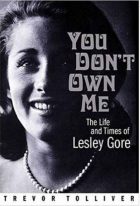 Tolliver, Trevor. You Don’t Own Me: The Life and Times of Lesley Gore. Backbeat Books, 2015. HC. $24.99. ISBN 978-1-4950-24412.
Tolliver, Trevor. You Don’t Own Me: The Life and Times of Lesley Gore. Backbeat Books, 2015. HC. $24.99. ISBN 978-1-4950-24412.
During my mid-1960s grade school years, Lesley Gore was my #1 pop icon. I memorized her songs and regaled everyone with my questionable imitation of her singing style. When she publicly declared her lesbianism in 2005, it was gratifying to know we were “bonded” yet again.
Gore died last year at age 68, and we baby boomers were reminded anew of the pivotal role she played in American culture during her brief years in the white-hot spotlight. Author Tolliver gives us a workable, if somewhat flawed, combination biography/analysis of a multi-talented woman who never truly left our radar.
Gore was born in 1946 New Jersey. By age 16, thanks to legendary producer Quincy Jones, she had two mega-hits to her credit: “It’s My Party,” and the pre-Women’s Liberation anthem “You Don’t Own Me.” Additional singles and albums followed, mostly in the “teenage girl loves boy, loses boy, maybe finds another boy” genre, making Gore a household word until she temporarily bowed out to attend college. It was during those late-1960s student years that she would self-acknowledge her lesbianism and soon afterwards come out to family and close friends (though, needless to say, not to the public at large).
By 1968, however, Lesley Gore was almost a has-been; some less successful albums and changing musical tastes contributed to her rapid popularity decline. However, as she had always ultimately aspired to be a songwriter, Gore changed career directions as best she could over the decades to come.
Additional sporadic albums would follow, reflecting her creativity and new maturity, and they were often highly praised, yet commercially unsuccessful. Thus, her singing career would never again soar to its former heights. At her death, however, Lesley Gore could boast a 30-year relationship with a female partner, a considerable body of unique if largely unknown work, and an undeniable place in American pop history.
Tolliver does a decent job in detailing both Gore’s life story and the times in which she flourished, although his song-by-song analysis of her recorded output sometimes becomes tedious. This book is also not especially well written, and includes some grievous proper name misspellings and other errors. However, he does convey what the 1960s pre-British Invasion recording industry demanded from its artists and audiences, and how significantly Lesley Gore fit into that picture.
With a few caveats, this book is recommended for general performing arts and LGBT biography collections. Lesley Gore’s star may have flickered only briefly, but she nonetheless deserves our memories and gratitude.
Cathy Ritchie
Acquisitions/Selection Services
Dallas (TX) Public Library
